Working from a cramped corner, converted closet, or shared living space doesn’t mean sacrificing productivity or style. As hybrid work becomes the norm in 2025, millions of professionals face the same challenge: creating an efficient workspace in impossibly small quarters.
The good news? With smart organization strategies and the right approach, even the tiniest nook can become a powerhouse of productivity.
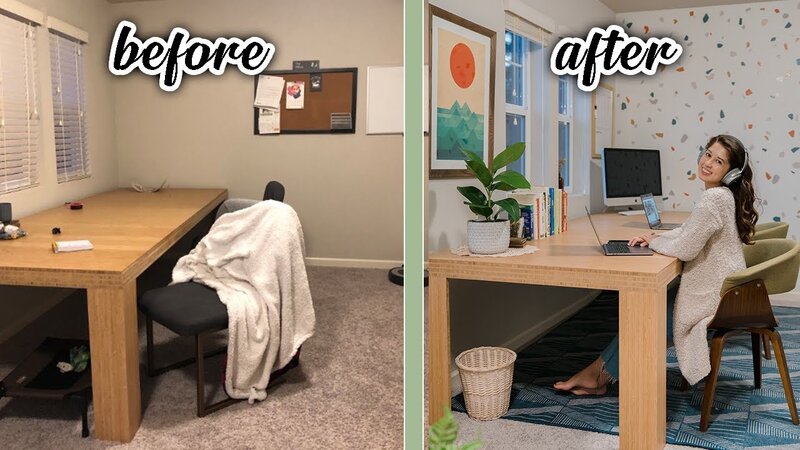
This guide delivers 25 practical organization ideas, space-saving furniture solutions, and proven techniques to transform your compact workspace. Whether you’re dealing with a studio apartment corner or carving out space in a busy household, you’ll discover actionable solutions that work within your constraints—and your budget.
You’ll Learn
- How to maximize even the tiniest nook or closet into a productive workspace
- 25 practical organization ideas with step-by-step tips, cost, and time estimates
- The best furniture, storage, and ergonomic solutions for small spaces
- Smart tech and 2025 design trends for compact home offices
- Maintenance habits and daily routines to keep your space clutter-free
- DIY projects, quick hacks under $50, and case study examples
25 Practical Small Home Office Organization Ideas
1. Floating Wall Desk / Wall-Mounted Fold-Down Desks
Install at 29-30″ height for optimal ergonomics. Best for spaces under 50 sq ft where floor space is premium. Mount into studs using heavy-duty brackets rated for 50+ lbs.
Cost: $75-300 | Time: 2-3 hours
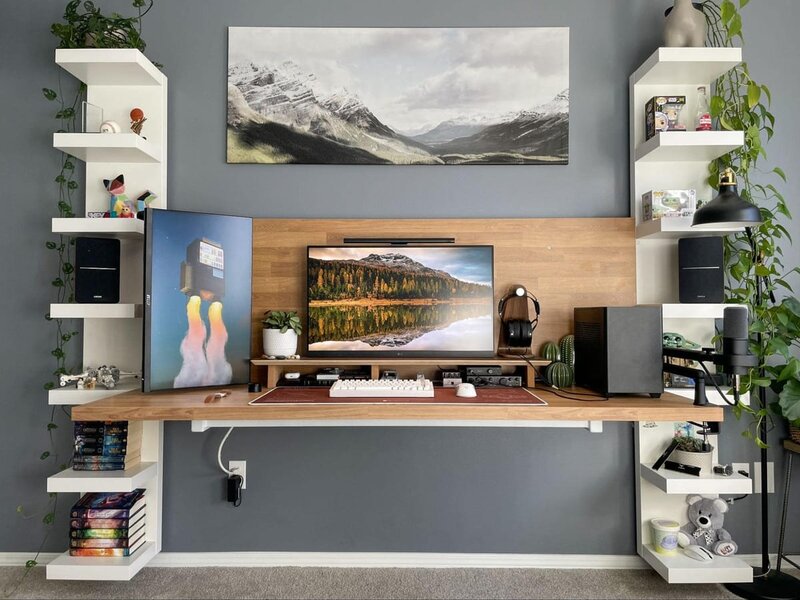
2. Closet-to-Office (Cloffice) Conversion
Minimum viable dimensions: 24″ deep x 30″ wide. Add LED strip lighting under shelves, install a desktop at elbow height, remove doors or replace with curtains.
Cost: $150-500 | Time: Weekend project
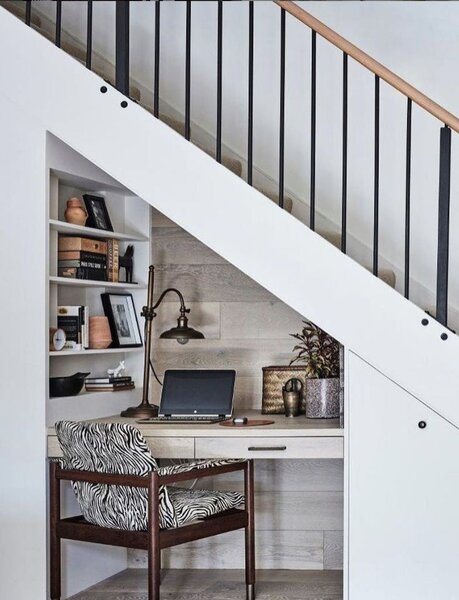
3. Under-Stair Nook Office
Measure headroom carefully—minimum 60″ at seated position. Install adjustable shelving on the tall side, task lighting on the low side.
Cost: $200-600 | Time: 1-2 days
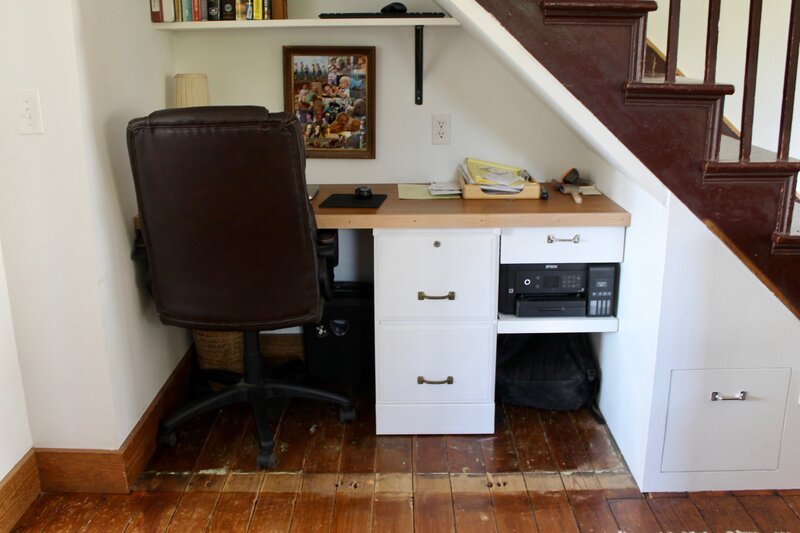
4. Floating Shelves + Ledges
Position 12-16″ above desk surface for easy reach. Use 2″ lip ledges for items that slide. Install in a zigzag pattern to maximize visual interest while maintaining function.
Cost: $30-150 | Time: 2 hours
5. Pegboards and Slatwall Systems
Mount 4’x4′ pegboard centered behind desk. Paint to match wall color for seamless integration. Add varied hooks, bins, and shelves for customization.
Cost: $40-200 | Time: 3 hours
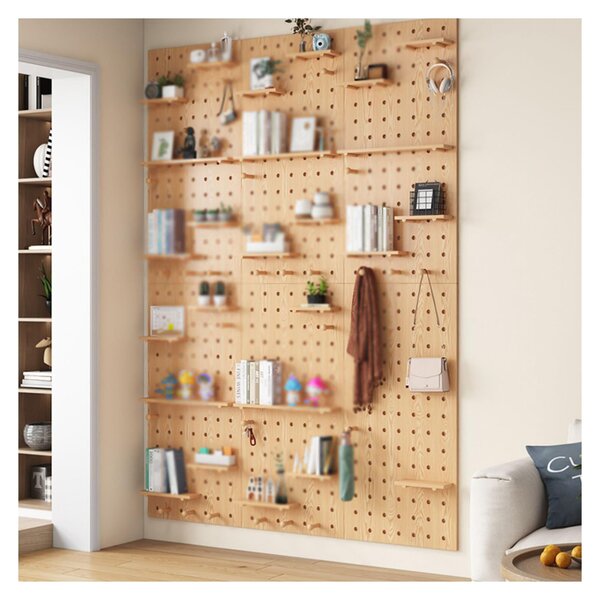
6. Magnetic/Command Strip Organization
Use industrial-strength magnetic strips for metal items. Command strips hold up to 16 lbs—perfect for routers, power strips. Replace every 12 months for reliability.
Cost: $15-40 | Time: 30 minutes
7. Monitor Risers and Laptop Stands
Choose adjustable models 4-8″ high with storage underneath. Position top of screen at eye level when seated. Creates 100+ sq inches of usable desk space.
Cost: $25-80 | Time: 5 minutes
8. Drawer Organizers and Modular Inserts
Measure drawer dimensions first. Use bamboo or acrylic dividers with 2-3″ compartments. Label each section with removable tags.
Cost: $20-60 | Time: 30 minutes
9. Cable Management Raceways & Clips
Install J-channel raceway along desk edge. Use spiral wrap for grouped cables. Add cable clips every 12″ for individual runs.
Cost: $15-45 | Time: 1 hour
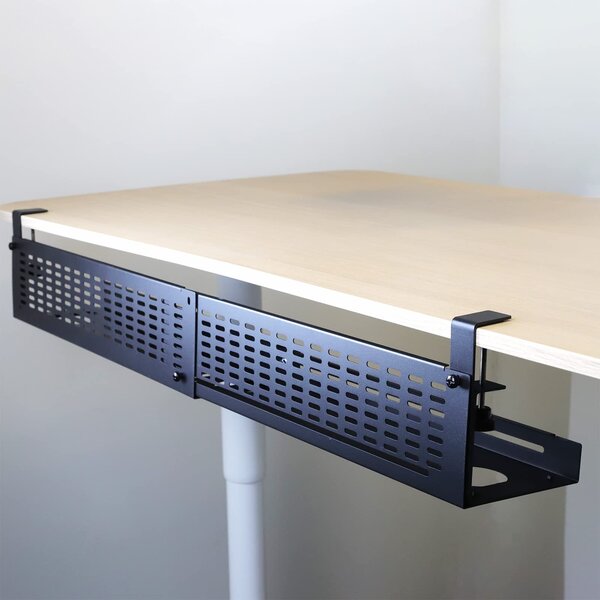
10. Hidden Storage: Ottomans & Benches with Compartments
Select models with 15+ lbs capacity. Use for seasonal items, extra supplies, reference materials. Position within arm’s reach of desk.
Cost: $50-150 | Time: No installation
11. Under-Desk Rolling Drawers
Look for units 15″W x 20″D maximum for clearance. Choose soft-close drawers to minimize noise. Lock wheels when stationary.
Cost: $40-120 | Time: 15 minutes assembly
12. Vertical File Towers and Slim Lateral Files
Opt for 12″ wide vertical files for tight spaces. Use hanging folders with clear tabs. Digitize and archive quarterly.
Cost: $60-200 | Time: 1 hour setup
13. Wall-Mounted Foldaway Printer Stations
Install shelf 24″ wide minimum at shoulder height. Add fold-down door to hide when not in use. Include paper storage below.
Cost: $80-250 | Time: 3 hours
14. Multi-Purpose Room Dividers with Storage
Choose 6′ tall units with shelving on both sides. Use as backdrop for video calls. Anchor to wall for stability.
Cost: $100-400 | Time: 1 hour assembly
15. Compact Ergonomic Chairs & Stool Options
Measure clearance: need 24″ minimum width. Choose armless designs for tucking under desk. Prioritize lumbar support over features.
Cost: $100-350 | Time: 30 minutes assembly
“The key to small office success isn’t adding more—it’s choosing multipurpose solutions that work harder in less space.”
16. Lighting Layering: Task, Ambient, Accent
Position task light opposite dominant hand. Add bias lighting behind monitor. Use warm white (3000K) for comfort.
Cost: $40-150 | Time: 1 hour
17. Acoustic Panels: Soft Wall Tiles & Bookcase Placement
Install panels at ear level when seated. Cover 25-30% of wall surface for effective sound dampening. Position bookcases perpendicular to walls.
Cost: $50-200 | Time: 2 hours
18. Biophilic Accents: Small Plants That Improve Air & Mood
Low-light champions: pothos, snake plant, ZZ plant. Position within sight line but not blocking screen. Water weekly with desk reset routine.
Cost: $20-60 | Time: 15 minutes
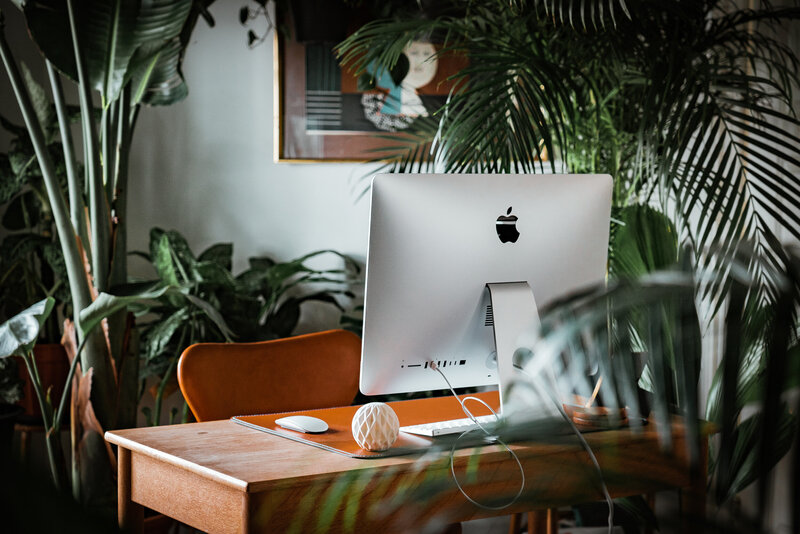
19. Color and Visual Cues to Delineate Workspace
Use area rug to define office zone. Paint accent wall or use removable wallpaper. Choose calming blues/greens for focus.
Cost: $30-150 | Time: 2-4 hours
20. Smart Storage Labels & QR Indexing
Create QR codes linking to digital inventory lists. Use consistent label maker fonts. Review and update quarterly.
Cost: $25-50 | Time: 2 hours initial setup
21. Cable-Free Desk Zones
Invest in Qi wireless charging pad. Choose Bluetooth keyboard/mouse with 3+ month battery life. Keep charging station in drawer.
Cost: $60-150 | Time: 30 minutes
22. Compact Standing Desk Converters
Desktop converters need 22″D x 30″W minimum. Full standing desks work in spaces 4’x4′ or larger. Test stability before purchasing.
Cost: $150-400 | Time: 30 minutes-2 hours
23. Portable Privacy Screens & Pop-up Booths
Acoustic screens reduce noise by 10-15 dB. Choose 5′ tall minimum for seated privacy. Store flat against wall when not needed.
Cost: $80-300 | Time: No installation
24. Daily Reset Ritual
5-minute checklist: clear desktop, file papers, charge devices, empty trash, wipe surfaces. Set phone reminder for consistency.
Cost: Free | Time: 5 minutes daily
25. Seasonal Purge & System Audit
Quarterly review: measure usage of each item, photograph setup for reference, donate unused items, update digital filing system.
Cost: Free | Time: 2 hours quarterly
How to Evaluate Your Small Office
Before implementing any organization system, assess your space objectively. Measure these critical dimensions: desk depth (minimum 20″ for comfort), available wall height (ceiling to desk surface), and nook width (account for chair movement). Document electrical outlet locations and natural light sources.
Define your primary work activities to guide storage decisions. Video call professionals need different setups than designers or writers. Create a priority list: Do you need privacy for calls? Physical document storage? Space for dual monitors? Equipment for specific tasks?
Task-to-Feature Quick Reference
| Task Type | Must-Have Features |
|---|---|
| Video Calls | Good lighting, clean background, acoustic treatment |
| Design Work | Large monitor support, color-accurate lighting, tool storage |
| Writing/Research | Document organization, reference shelf, minimal distractions |
| Administrative | Filing system, scanner access, supply storage |
| Coding/Technical | Dual monitor capability, cable management, ergonomic setup |
Top Principles for Organizing Small Home Offices
Principle 1: Think Vertical
Vertical storage multiplies your usable space without expanding your footprint. Install shelving from 12″ above desk height to ceiling. Use wall-mounted rails for frequently accessed items.
Pegboards offer infinite customization—reorganize as needs change. The wall behind your monitor often goes unused; reclaim it with shallow shelves or magnetic boards.
Principle 2: Multi-Function Furniture
Every piece should serve at least two purposes. Fold-down desks disappear when work ends. Storage ottomans provide seating and supply storage. Murphy desks with integrated shelving combine workspace and organization.
Convertible standing desk converters transform static desks into ergonomic workstations without permanent installation.
Principle 3: Declutter & Digitize
Physical clutter multiplies in small spaces. Implement a “one in, one out” policy for office supplies. Scan documents immediately, then shred or file originals off-site. Use cloud storage for reference materials.
Keep only this week’s active projects on your desk. Archive completed work monthly.
Principle 4: Design for Ergonomics
Small spaces often compromise posture and comfort. Invest in adjustable solutions: monitor arms save 6″ of desk depth while positioning screens correctly. Compact keyboards reduce reach. Under-desk keyboard trays create more surface area.
Even in 3’x3′ spaces, proper ergonomics remain achievable with thoughtful selection.
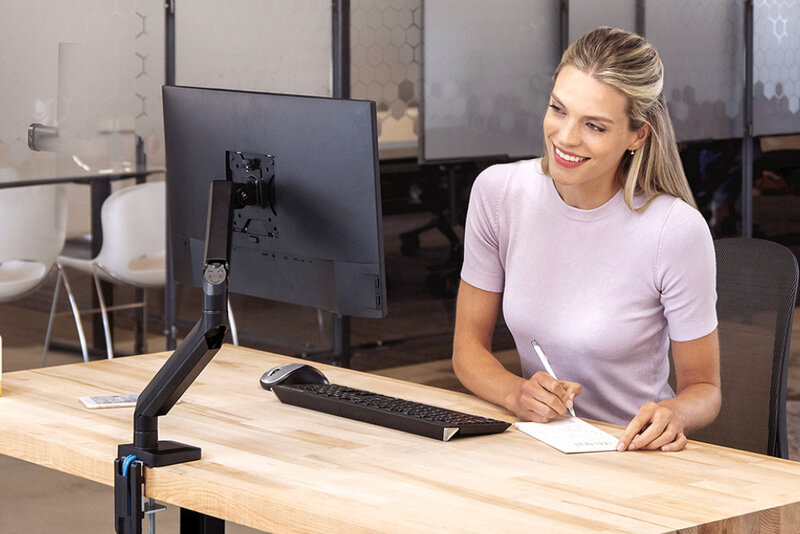
Principle 5: Zone by Function
Divide your tiny space into micro-zones. Designate areas for focused work, video calls, and storage—even if zones overlap. Use visual cues: a desk lamp defines the work zone, a ring light indicates the meeting zone.
This mental separation improves focus despite physical constraints.
Quick Wins: 10 Low-Cost Organization Hacks Under $50
- Binder clips as cable managers – Clip to desk edge, thread cables through metal handles ($5)
- Shower caddies for supply storage – Hang on wall or cubicle partition ($10-15)
- Magazine holders as vertical files – Stack horizontally for instant shelving ($15-20)
- Tension rods under desk – Hang baskets or power strips out of sight ($10-20)
- Adhesive hooks everywhere – Back of door, under desk, side of filing cabinet ($5-10)
- Repurposed spice racks – Perfect for small office supplies, sticky notes ($15-25)
- Velcro strips for remotes and tools – Attach frequently used items to desk underside ($8-12)
- Clear shoe organizers – Over-door storage for cables, supplies, notebooks ($10-20)
- Magnetic knife strip for scissors/tools – Mount on wall or inside cabinet ($15-25)
- Grid photo displays as memo boards – Clip notes, calendars, inspiration ($20-30)
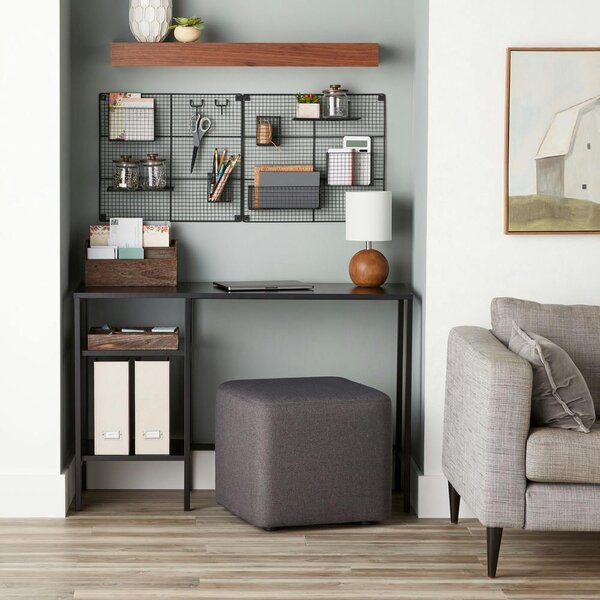
Smart Tech & 2025 Trends
Smart Lighting & Circadian-Friendly Bulbs
Modern smart bulbs adjust color temperature throughout the day, supporting natural circadian rhythms. Program cool white (5000K) for morning focus, warm white (2700K) for evening wind-down.
Smart switches enable voice control and scheduling—critical when desk lamps are hard to reach in tight spaces.
Home-Office IoT
Smart plugs transform basic equipment into automated systems. Create “focus mode” scenes that activate desk lamp, white noise, and phone charger simultaneously. Smart power strips cut phantom power draw when workday ends.
Choose hubs compatible with your existing ecosystem (Alexa, Google Home, HomeKit).
Minimalist Cableless Setups
Wireless technology eliminates cable chaos. USB-C docking stations support single-cable connections for laptops. Choose docks with 65W+ power delivery, dual display support, and front-facing USB ports.
Position dock vertically to minimize desk footprint. Wireless mechanical keyboards and premium mice now match wired performance.
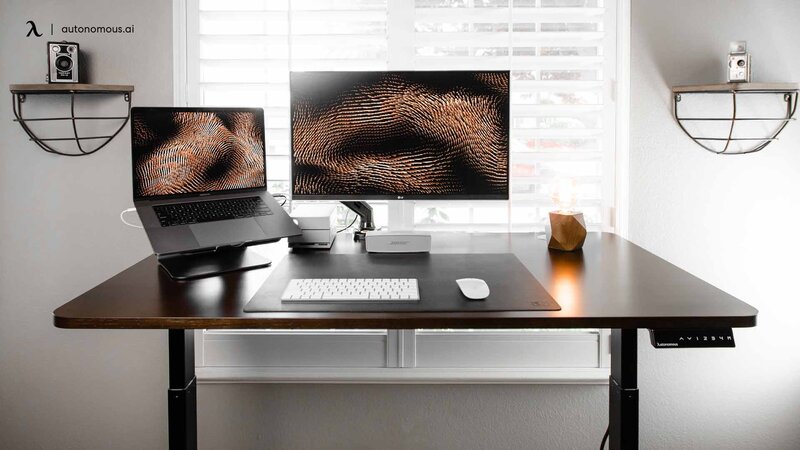
Top smart devices to pair with a small desk: Wireless charging pad with multiple coils, USB-C hub with 100W PD, Smart LED strip for bias lighting, Bluetooth speakerphone for calls, Smart power strip with scheduling
Ergonomics in Tight Spaces
Chair selection becomes critical with only 18-22″ of clearance. Prioritize seat depth adjustment and lumbar support over armrests. Mesh backs reduce visual bulk. Consider ergonomic stools or balance ball chairs for ultra-tight spaces—they tuck completely under desks.
Monitor arms reclaim 6-8″ of desk depth while enabling proper positioning. Choose arms with 15+ lbs capacity for future monitor upgrades. Gas spring models offer smoother adjustment than mechanical arms.
For laptop users, vertical laptop stands paired with external monitors optimize both ergonomics and space.
Micro-adjustments make major differences. Keyboard tray height should allow 90-degree elbow angle. Add footrest if feet don’t touch floor. Implement 20-20-20 rule: every 20 minutes, look at something 20 feet away for 20 seconds. Set hourly stand/stretch reminders.
Acoustics, Lighting & Backgrounds for Video Calls
Affordable acoustic upgrades dramatically improve call quality. Felt tiles (1″ thick minimum) absorb high frequencies when placed at ear level. Position bookcases perpendicular to walls to break up sound reflection.
Soft furnishings—curtains, rugs, upholstered furniture—reduce echo without dedicated treatment.
Create flattering video lighting with three sources. Key light: 45 degrees to your strong side, slightly above eye level. Fill light: opposite side, dimmer to create subtle shadows. Background light: prevents you from appearing flat against background.
Ring lights work but can cause eye strain; prefer soft box or panel lights.
Choose backgrounds that enhance professionalism without distraction. Styled bookshelves suggest expertise. Plants add life without movement. Avoid windows behind you (backlight issues) and doors (privacy concerns).
Test your background at different times—natural light changes throughout the day.
Storage Comparison Table
| Solution | Footprint | Capacity | Cost Range | Best For |
|---|---|---|---|---|
| Floating shelf system | Low | Medium | $30-$300 | Decorative storage, books |
| Under-desk rolling drawer | Medium | High | $40-$150 | Files, supplies |
| Wall pegboard/slatwall | Low | Low-Medium | $20-$200 | Tools, frequently used items |
| Closet conversion (cloffice) | High (built-in) | High | $100-$1,500+ | Full workstation, hidden door |
| Fold-down wall desk | Very low (closed) | Low | $50-$400 | Very small apartments |
DIY Projects & Quick Builds
Simple Floating Desk (Afternoon Project)
Materials: 2″ thick wood slab (24″x48″), heavy-duty brackets, wall anchors, sandpaper, finish. Mount brackets into studs 29″ from floor. Sand and finish wood before mounting.
Total cost: $60-100. Creates minimalist workspace with zero floor footprint.
Pegboard Organizer (30-60 Minutes)
Materials: 2’x4′ pegboard, spacers, screws, paint (optional), variety pack of hooks. Paint pegboard before mounting. Install with 1″ spacers for hook clearance. Arrange accessories based on frequency of use.
Total cost: $30-50.
Bookshelf Workspace Conversion
Remove one shelf at desk height (29-30″). Add LED strips under remaining shelf for task lighting. Install power strip to back panel. Use bookends to create vertical files. Add pull-out keyboard tray if depth allows.
Total cost: $40-80.
Product Recommendations & When to Splurge vs Save
Smart Splurges:
- Ergonomic chair – Your back will thank you ($200-500)
- Monitor arm – Transforms desk usability ($100-200)
- Task lighting – Reduces eye strain significantly ($50-150)
- Docking station – Simplifies daily setup ($100-250)
Smart Saves:
- Cable clips – Generic work identically to branded ($5-10)
- Desk organizers – Dollar store options suffice ($5-20)
- Storage boxes – Aesthetics matter less inside drawers ($10-30)
- Decorative items – Minimal impact on productivity ($0-50)
For more detailed reviews of desk organizers and ergonomic accessories, check out our comprehensive buying guides.
Maintenance: Checklists for Sustained Organization
5-Minute Daily Reset
- [ ] Clear desktop to baseline state
- [ ] File or scan loose papers
- [ ] Empty physical and digital trash
- [ ] Charge all devices
- [ ] Wipe down surfaces with microfiber cloth
30-Minute Weekly Refresh
- [ ] Process inbox (physical and digital)
- [ ] Reorganize supply drawers
- [ ] Dust electronics and shelves
- [ ] Update task lists and calendars
- [ ] Review and adjust lighting/ergonomics
1-Hour Quarterly Audit
- [ ] Purge unused supplies and outdated documents
- [ ] Deep clean all surfaces and electronics
- [ ] Test and update cable management
- [ ] Photograph setup for insurance/reference
- [ ] Measure and document any needed upgrades
Examples + Mini Case Studies
Studio Apartment Cloffice Transformation
Challenge: 450 sq ft studio with no dedicated office space
Solution: Converted 24″x30″ coat closet into full office. Removed doors, installed floating desk at 29″, added three shelves above, LED strips for lighting. Murphy board on inside wall for notes.
Cost: $280 total
Result: Complete office that disappears behind curtain after hours
Shared Living Room Dual Zone
Challenge: Couple both working from home in 12’x14′ living room
Solution: Created L-shaped zone with two floating desks on perpendicular walls. Shared vertical storage in corner. Wireless peripherals prevent cable crossing. Acoustic panels behind each desk.
Cost: $425 total
Result: Two functional workspaces with visual privacy
Hallway Niche Conversion
Challenge: Dead space in 3′ wide hallway alcove
Solution: Wall-mounted fold-down desk, vertical pegboard storage, acoustic tiles to dampen hallway noise. Under-desk ottoman stores supplies.
Cost: $195 total
Result: Hidden office that maintains hallway flow
FAQs
Scan immediately upon receipt. Keep only current project papers physical. Use vertical magazine files for active documents. Archive quarterly to off-site storage or digitize completely.
Armless task chairs or ergonomic stools work best. Look for models with waterfall seat edges and adjustable height. Consider backless options that tuck completely under desk when not in use.
Install cable raceway along desk back edge. Use spiral wrap for grouped cables. Position power strip behind monitor using command strips. Route all cables down single channel to floor.
Yes, if you need door-closing privacy and have alternative storage. Minimum viable dimensions: 24″ deep, 30″ wide. Budget $200-500 for basic conversion. Adds significant home value in markets valuing remote work capability.
Transform Your Space Today
Small space constraints don’t have to limit your productivity or professional growth. Start with one organization idea from this guide—perhaps the 5-minute daily reset or a simple pegboard installation. Build momentum with quick wins, then tackle larger projects as you see results.
Ready to take your workspace to the next level? Discover premium organization solutions and ergonomic furniture designed specifically for compact home offices at Focus Mode HQ. Our curated collection helps remote professionals maximize every square inch while maintaining style and comfort.
For more workspace inspiration, explore our guides on desk setup ideas and productivity accessories to create your perfect work environment.
